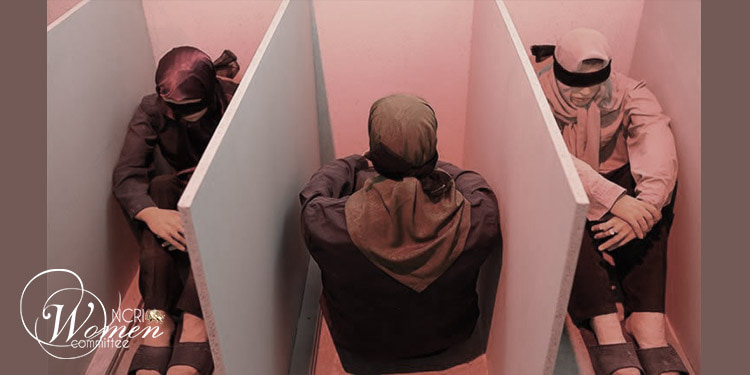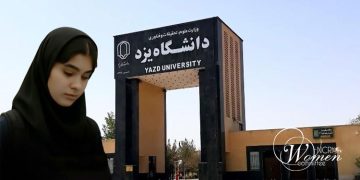From the memoir by Hengameh Haj Hassan – Part 16
In part 15 of Face to Face with the Beast, Hengameh Haj Hassan recounted being transferred into a coffin-like cage inside Ghezel Hesar prison, part of a project designed to break prisoners and force them into repentance.
In this episode, she continues describing the suffocating days and nights inside those cages, where survival meant resisting not only physical suffering but also psychological suffocation.
⚠️ Cautionary Note: This memoir contains descriptions of imprisonment, torture, and executions under the Iranian state. Some passages may be distressing to readers.
Suffocation in the Cage
I don’t remember if they took me somewhere else, but in my mind, I still see myself sitting in the middle of a large room. A short distance to the right there was a bathroom with hot water running—maybe a shower, maybe just a faucet—and a woman washing something. Beyond that, I remember nothing.
I was kept in that condition for about a week, not allowed to remove my chador, headscarf, or blindfold. I wasn’t even allowed to cough or speak. If I had an emergency, I had to raise my hand. The whole time I sat upright, never lying down. Strange! Why wouldn’t they at least let me lie down? I was sick. Even between those two wooden planks I could have stretched out; it was like a coffin. I think it must have been a small room with a bathroom, or perhaps just the bathroom itself.
The air there suffocated me. I was restless. How long would they keep the blindfold on? Surely this was temporary, and they’d remove it once I was moved elsewhere. Sometimes the air felt so unbearable I thought I was dying—but then I would wake up later, realizing I hadn’t died. I must have fainted in that sitting position, probably from the blows to my body.
After about a week, one day they came and told me to stand up. They led me out of the room. As soon as I stepped outside, I felt like I could finally breathe again. My mind became clear. I still don’t know how that week passed; I only remember fragments. I don’t even recall anything about that woman anymore.
They took me toward the zir-e hasht (the prison’s main security office)[1] and into a large room on the left. There, they handed me over to another woman and told me to remove my chador and blindfold. I did and froze in shock. It was Kianoush. She had once been a defiant fighter, almost like Che Guevara, but now she stood before me in a black chador and scarf, ready to conduct a body search. Her face was identical to that of the female guards. What a world! Just two weeks earlier she had been a fierce comrade, and now she was one of them.
She avoided looking into my eyes while patting me down, trying to “advise” me with meaningless words. At one point she said, “People outside need us. Why should we waste ourselves in here?”
I snapped back: “People don’t need trash like you. Don’t worry about them. Just do your own job.”
She fell silent. Those were the last words I ever said to her.

They placed me inside another cage, in the same conditions as before: blindfold, chador, forced sitting, back to the wall between two planks spaced half a meter apart—again, like an open coffin.
This time, though, my mind was clearer. The air was cold, and I realized that Hajji’s “repentance factory” was based here, in these cages. Filthy creatures! They thought they could mass-produce broken prisoners. They were so confident in their “method” that they believed it would work on all of us.
I thought of Masoud[2], of his eight years of torture and suffering, of his speech in Amjadieh Stadium. I felt him beside me. I remembered interrogations, the night we counted 120 executions, then 220 gunshots to finish them off. I remembered the night of the execution of Tahmineh, Touba, and Kobra. Impossible! Hadn’t God said: “God does not burden a soul beyond what it can bear” (Qur’an 2:286)? If God placed this test upon me, it meant He knew I had the capacity to endure it. Therefore, I could endure.
These thoughts breathed new life into me. Just hours earlier, the blindfold had felt like the suffocating weight of the grave. I had been screaming inside: When will they take off this cursed blindfold? Now I was preparing myself to live with it forever.
Hajji, you filthy coward! We will never give you the satisfaction of defeating a Mojahed. I felt as though I had a powerful weapon, firing my hatred directly into the heart and brain of that beast. Strangely, I was overcome with a feeling of victory, a fullness of spirit.
Days passed in this way. Hajji came daily, silently inspecting his device. I could sense his vile presence, but it was useless—the “repentance machine” had serious malfunctions. The “mass production” he bragged about never materialized.
The schedule was rigid: at dawn, between 5 and 6 a.m., we were woken by the call to prayer. Three minutes for the toilet and ablutions, five minutes for prayer, then back to the cage for breakfast. Before noon, again three minutes for the toilet, then prayer, then lunch, then more hours in the cage. In the evening, the same: three minutes toilet, prayer, dinner, then sitting until midnight. Only then were we allowed to lie down and sleep usually four to five hours before the next day began.
And so, the endless cycle of days, weeks, and months rolled on.
For prayers, they hung military blankets as partitions, forming a tiny cubicle. When I felt unobserved, I peeked through the gap. It was a zurkhaneh (a traditional Iranian gym for wrestling and strength training)[3], complete with a sunken arena. Later, I discovered that an identical setup existed in Unit 3.
Around the perimeter of the walls, every half meter, wooden planks had been placed upright, forming dozens of cages, maybe 80 or 90 in total. Each cage held one prisoner sitting against the wall. In the middle of the arena were the prisoners’ belongings and bags. By studying the bags, I tried to figure out who had been brought there. My own cage was to the left, about five meters from the entrance, with five or six cages before mine.
The prayer space was by the left wall, between two windows. When we removed our blindfolds for prayer, I could see the guard tower and the soldier on watch. From this spot, I could observe the entire hall each day, checking which cages emptied, which filled, and who was brought in.
Every day, loudspeakers blared the harsh mourning chants of Ahangaran[4] and others beating the “drum of war.” News reports of the regime’s “glorious victories” at the frontlines of the war of “truth against falsehood” filled the air nonstop. And then came the “Ershad Unit”[5] propaganda broadcasts, which, thankfully, we weren’t forced to attend, though we had to hear them anyway so we wouldn’t “fall behind on current events.”
To be continued…
[1] Zir-e hasht – The central security office of the prison.
[2] Massoud Rajavi – The leader of the People’s Mojahedin Organization of Iran (PMOI/MEK). He was imprisoned and tortured under the Shah in the 1970s and later became the central figure of the movement. For many Mojahedin prisoners, he symbolized resistance and endurance.
[3] Zurkhaneh – A traditional Iranian gym, often used for wrestling and strength training, which the regime here repurposed into a hall of cages.
[4] Sadegh Ahangaran – A famous maddah (religious eulogist) of the clerical regime, whose battle anthems were used as propaganda during the Iran–Iraq War.
[5] Ershad Unit – A “guidance” or indoctrination program inside prisons, where prisoners were forced to listen to religious and political propaganda aimed at breaking their resistance.
























